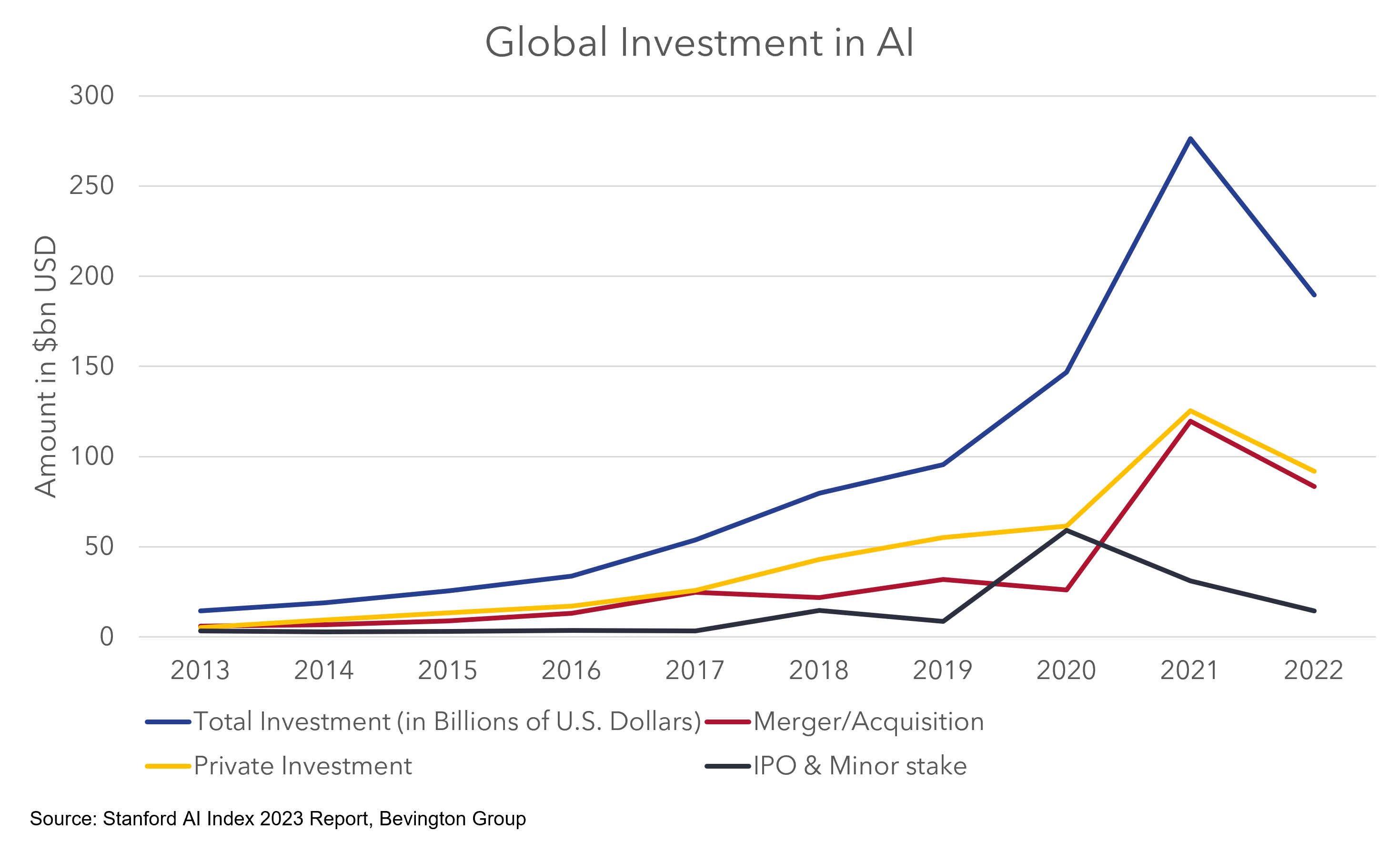The advent of ChatGPT-4 caused a stir in the press and the market. It’s remarkable how quickly AI has progressed from GPT3.5 to GPT4, demonstrating its fast, continuous development. This rapid progress is due to enhanced computing power and the increasing efficiency and effectiveness of AI developers in training these agents.
Furthermore, despite some temporary economic headwinds leading to a drop in investment, the AI industry still saw nearly $200 billion being invested in 2022. This level of interest and funding indicates that AI’s evolution is far from stagnant and is bound to continue its trajectory of growth.

To grasp the scope of AI’s impact, one needs to consider the sheer number of AI agents available. It’s not just about OpenAI’s platform or ChatGPT; there are thousands of AI agents being utilised in various domains. This growing AI landscape has given rise to remarkable innovations, such as AI-enabled robots with human-like capabilities and the creation of a digital image of a customer, as demonstrated by “Live Persons Customer 360.”
Watch Roger Perry’s presentation on ‘Changing Your Organisation with AI’ by clicking here.
Emerging AI Use Cases
Early AI use cases are already demonstrating remarkable potential and promise. Some of these emerging applications include:
- Dramatically improved decision-making: AI can assist in creating the first draft of reports, conducting research, and extracting valuable insights from data, leading to better decision-making processes and outcomes.
- Massively improved customer segmentation: AI’s ability to identify patterns in data allows for hyper-personalised customer experiences, significantly enhancing customer satisfaction and loyalty.
- Enhanced chatbot capability: With improved training, AI-driven chatbots are becoming more efficient and helpful, offering better customer service experiences.
- Automation of entire processes: Robotic Process Automation (RPA) has evolved into Intelligent Automation, allowing for both process automation and decision-making
capabilities, resulting in faster deployment of digital solutions which can reduce both error rates and costs. - Improved data cleansing: AI-driven data cleansing can ensure data accuracy and quality, thus leading to better training of AI agents and more reliable results.
- Difficult optimisation tasks: AI can handle complex optimisation tasks like roster automation, streamlining operations, and improving resource management.
AI’s Impact on the Operating Model: Embracing Opportunities Across Domains
All the above examples are already extant in the Australian marketplace, and while it is clearly still early, the impact of AI on an organisation’s operating model will be profound and far-reaching. Our approach defines an operating model as all the components of an enterprise needed to achieve the mission consistent with strategy – and the way they interact. Every aspect of the operating model can be impacted by AI, including: organisational structure, processes, measures, skills, and ways of working. With AI agents making their way into every model component, organisations have endless opportunities to explore.
Consider the service model, for instance. AI can hyper-personalise experiences through intelligent segmentation or create digital customer profiles to better understand their preferences and needs. More mundane tasks can be delegated to AI agents, supporting and empowering knowledge workers. Developing the necessary skills and capabilities to collaborate effectively with AI agents is critical, as it becomes an integral part of an employee’s daily routine.
The Risks of a Sluggish Response
It’s crucial to recognise that ignoring the potential of AI can be both helpful and detrimental to an organisation’s future. To give you a sense of the risks, consider not adopting AI can lead to a sluggish response to marketplace changes, leaving you vulnerable to more agile competitors who leverage AI for predictive insights and market adaptation. Or contemplate A failure to use AI for cost reduction and process optimisation can result in higher operational expenses, putting your organisation at a disadvantage in pricing and market competition.
Furthermore, not leveraging AI for customer customisation and personalisation can lead to loss of market share and customer loyalty as competitors excel in meeting individual needs. In the case of government agencies and not-for-profit entities, failure to embrace AI could result in mission failure, as stakeholders and funders expect enhanced performance in an AI-driven world.
A Holistic Approach to AI Implementation
When approaching AI strategically, several methodologies can be considered. It is important to appreciate that AI is enabled by technology but fundamentally it is a strategic and people issue. Hence, scenario planning can be helpful in determining strategic responses. This involves envisioning various outcomes and developing strategies to tackle those scenarios effectively. Strategies that are useful in the greatest number of scenarios should be actively considered for deployment. This helps organisations adapt and respond to different AI-driven situations.
An approach that can be used in combination with scenario planning involves the use of value driver tree analysis to identify strategic options and the levers required to achieve them. By breaking down objectives into components like revenue and costs (and their drivers), organisations can determine which levers to pull to optimise AI implementation and drive desired outcomes. Importantly this analysis also gives helpful guidance on the metrics to use.
Additionally, considering AI’s impact on the operating model is important. In reality, AI can change the operating model, however, the smartest organisations are also changing their operating models to be flexible enough to incorporate AI – but do so safely. At Bevington we often restructure organisations to accelerate digital deployment, it is already clear that many of these techniques are also useful for preparing the organisation to deploy AI flexibly and safely.
To facilitate effective AI implementation, risk planning is essential, thereby understanding potential risks and developing mitigation strategies to avoid negative consequences. Fortunately, there are now rapidly maturing principles and frameworks to allow this to happen.
Finally, it is worth noting that assessing investment opportunities in AI might require multiple methods, from the scenario planning, value driver tree, and operating model methods described above, to thinking about AI preparedness as equivalent to buying an option or an insurance contract.
Embrace AI’s Evolution for Organisational Success
AI’s evolution is unstoppable, and at Bevington, we believe that there are early mover (though not necessarily first mover) advantages. Organisations that proactively embrace AI in their operating models stand to gain cost and revenue benefits, enabling further investment, thereby sparking a virtuous cycle. The potential for AI to enhance decision-making, automate processes, improve customer segmentation, and empower knowledge workers is immense. Strategically planning for AI integration and staying agile in a constantly evolving landscape is essential to thrive in the AI-driven future.
 |
Roger Perry – CEO Bevington Group One of the region’s foremost productivity improvement and organisational design experts, focused on ensuring successful organisational change, with demonstrated and quantified returns. |





